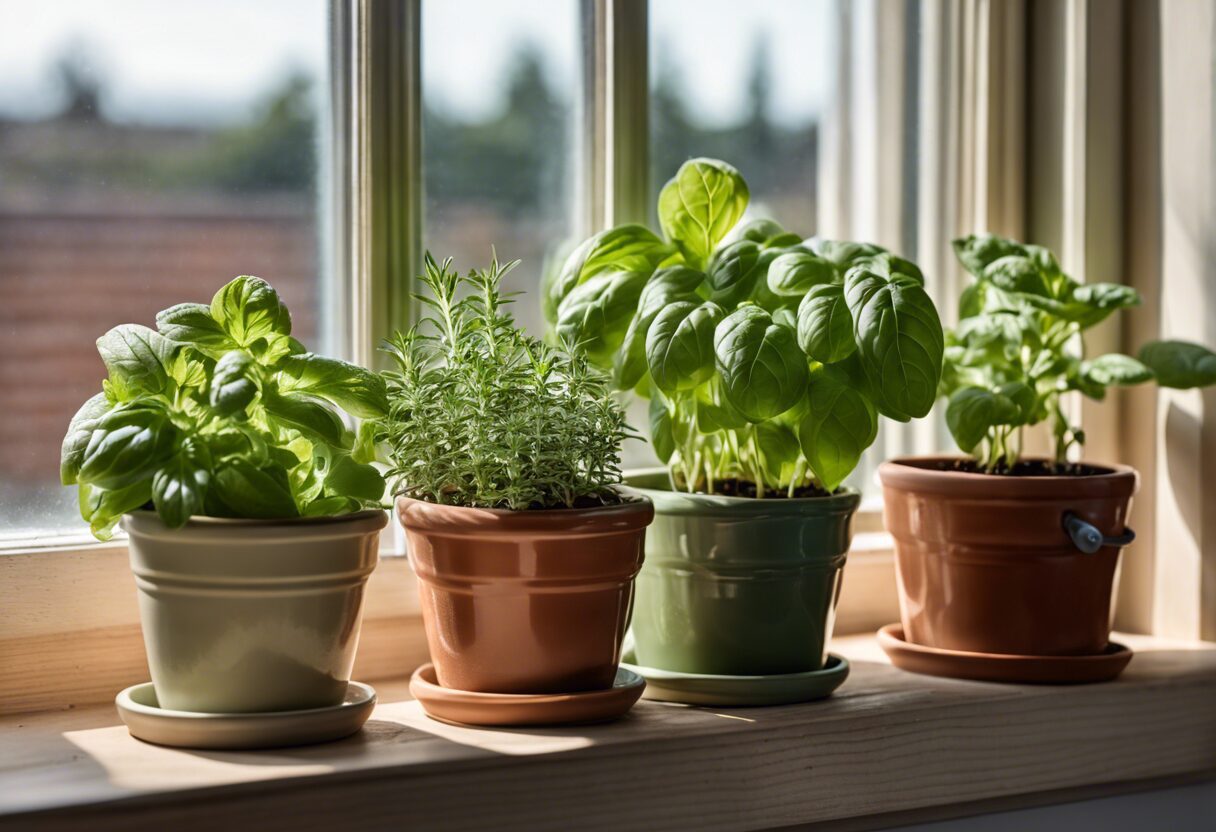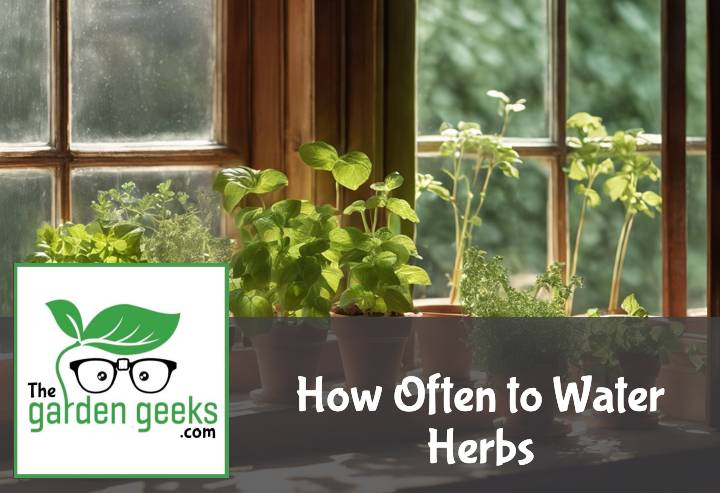Ever stood with a watering can in hand, looking at your herb garden and thought, “How much is too much?” Well, you’re not alone. The question of How Often to Water Herbs has puzzled many gardening enthusiasts just like you and me.
In this guide, we’ll try to unravel this mystery together. So put on your gardening gloves, grab a cup of tea (or maybe a mint julep made from your own homegrown mint), and let’s dive into the wonderful world of herb watering. Keep reading about ‘How Often to Water Herbs’.
Key Takeaways

- Watering frequency for herbs depends on the type of herb, its growth stage, and environmental conditions.
- Most herbs need watering once they’re dry to a depth of 1-2 inches. Overwatering can cause root rot.
- Indoor herbs typically require more frequent watering than outdoor ones due to drier indoor air.
- Mediterranean herbs like rosemary and thyme prefer drier soil, while basil and parsley need more water.
- Always check the soil moisture before watering. Use a moisture meter if necessary.
Understanding the Basics of Watering Herbs
Alright, let’s get down to the nitty-gritty of herb watering basics. It’s not rocket science, but understanding a few fundamentals can make a world of difference in your herb garden.


The Importance of Water for Herbs
Water is like the lifeblood for herbs. Without it, they’re as good as toast! It plays a crucial role in their growth and overall health. When you water your herbs properly, they flourish and produce those aromatic leaves we all love so much.
But here’s the thing: hydration and herb productivity are two peas in a pod. Too little water and your herbs might shrivel up; too much and they could drown. It’s all about striking that perfect balance.
Factors Affecting Water Needs in Herbs
Now, you might be wondering: “How on earth do I know how often to water herbs?” Well, there are several factors that come into play here.
First off, environmental conditions have a big say in this matter. If it’s scorching hot outside or if your herbs are under direct sunlight most of the day, they’ll need more water than those chilling out in cooler or shaded areas.
On top of that, specific plant characteristics also affect watering needs. Some herbs are like camels—they can go longer without water—while others prefer to stay hydrated at all times.
In short, understanding these factors in herb watering needs will help you keep your green buddies happy and healthy!
How Often Should You Water Indoor Herbs?
When it comes to indoor herb care, it’s crucial to get the watering frequency just right. Too much or too little water can lead to a host of problems, affecting your herbs’ health and growth. But don’t fret! We’re here to help you understand how often to water herbs indoors.
Identifying Signs of Overwatering and Underwatering in Indoor Herbs
First things first, let’s talk about the signs of overwatering and underwatering. If your indoor herbs are getting too much water, they might show symptoms like yellow leaves or a moldy smell. This is what we call overwatered herbs.
On the flip side, if your plants aren’t getting enough water, they might have dry, brittle leaves. These are classic signs of underwatered herbs. Remember, maintaining indoor herbs is all about balance!
Best Practices for Watering Indoor Herbs
Now that we’ve covered how to spot water damage in plants, let’s dive into some best practices for watering indoor herbs. The size of the pot plays a significant role in determining how much water your plant needs.
Humidity levels also matter when it comes to proper plant hydration. If you live in a drier climate, you might need to water more frequently than someone living in a humid area.
Lastly, remember that different types of herbs require different amounts of water. So do some research on your specific herb before going all out with the watering can! With these optimal watering techniques, you’ll be well on your way to maintaining healthy herbs indoors.



How Often Should You Water Outdoor Herbs?
When it comes to outdoor herb watering frequency, there’s no one-size-fits-all answer. It depends on a few factors, like the climate you’re in and the season. For instance, if you’re living in a hot, dry climate, your herbs will need more frequent watering compared to those in cooler climates.
Recognizing Signs of Overwatering and Underwatering in Outdoor Herbs
Let’s talk about how to spot when your herbs are getting too much or too little water. If your herbs are looking a bit droopy and their leaves are turning yellow, that could be a sign of overwatering. On the other hand, if they’re wilting and their leaves are brown or crispy, they might be underwatered.
Both scenarios can have serious effects on plant health and hinder herb growth. So keep an eye out for these signs! And remember, different types of outdoor herbs may show different symptoms, so do some research on your specific plants.
Best Practices for Watering Outdoor Herbs
Now onto some tips for keeping your herbs happy and hydrated! The best time to water is usually early morning or late evening when the sun isn’t as strong. This helps prevent the water from evaporating before it can soak into the soil.
As for how much water to use, well that depends on your herb type again. Some like it wetter than others! But generally speaking, you want to make sure the soil is moist but not soggy.
And don’t forget about weather conditions! If it’s been raining a lot lately, you might not need to water as often. But if it’s been hot and dry…well, you get the idea!
So there you have it folks – everything you need to know about how often to water herbs outdoors!
Specific Herb-Watering Guidelines
When it comes to how often to water herbs, there’s no one-size-fits-all answer. Each herb has its own unique hydration needs, and understanding these is key to maintaining healthy herbs. In this herb watering guide, we’ll delve into the specific care requirements for a variety of popular herbs.
Basil, Rosemary, and Thyme: How Often to Water?
Basil loves moisture! It’s like the drama queen of the herb world, wilting dramatically if not watered enough. But don’t let it fool you; overwatering can lead to root rot. Aim for a happy medium – moist but not soggy soil.
Rosemary and thyme, on the other hand, are more like the cool kids who don’t need much attention. These Mediterranean natives prefer drier conditions. Overwatering them is a surefire way to send them to plant heaven. So remember, when it comes to rosemary hydration tips or thyme water frequency, less is more!
Mint, Parsley, and Cilantro: How Often to Water?
Mint is pretty chill about its watering schedule. It likes consistently moist soil but won’t throw a fit if you forget a day or two. Just don’t let it dry out completely.
Parsley and cilantro have similar hydration needs – they prefer evenly moist soil too. However, be careful not to drown them in water; soggy soil can lead to root diseases. So when considering parsley hydration needs or cilantro water frequency, think “Goldilocks” – not too much, not too little, just right!
Chives, Dill and Oregano: How Often to Water?
Chives are easy-going plants that enjoy regular watering but can tolerate short dry spells. However, prolonged drought can make their leaves tough and less flavorful.
Dill prefers evenly moist soil, but it’s not overly fussy. Just avoid extremes – too much water can cause root rot, while too little can lead to wilting.
Oregano is a bit of a tough guy. It likes well-drained soil and can handle dry spells better than most herbs. Overwatering is its kryptonite though, so keep the oregano water requirements on the lower side.
Remember folks, understanding your herb’s individual watering frequency is key to keeping them happy and healthy!
Common Mistakes When Watering Herbs
When it comes to herb care errors, we often find ourselves in a Goldilocks situation. Not too much, not too little, but just right is the mantra for how often to water herbs. The most common herb watering mistakes are overwatering and underwatering.
Overwatering: Causes and Consequences
Overzealous plant parents are usually guilty of overwatering herbs. They mean well, but their love can drown the poor plants! Overwatering happens when you’re either watering your herbs too frequently or giving them more water than they can absorb at once. This leads to waterlogged soil and ultimately, root rot.
The consequences? Well, let’s just say it ain’t pretty. Herb water damage from overwatering can cause yellow leaves, wilting, and even death of the plant. It’s like giving someone a gallon of water to drink in one go – not fun!
Underwatering: Causes and Consequences
On the flip side, we have those who forget that plants need water to survive (oops!). These folks end up underwatered herbs due to neglect or simply not knowing how much water their herbs need.
The effects of underwatering are equally grim as overwatering. Your herbs may wilt, turn brown or dry up completely due to insufficient hydration. It’s like trying to run a marathon without drinking any water – yikes! So remember folks, balance is key when figuring out how often to water herbs.


To Wrap Up
In the jungle of plant care, we’ve explored the winding paths of ‘How Often to Water Herbs’. Remember, your herbs aren’t cacti; they need a drink more than once in a blue moon!
So, don’t be shy – give that watering can a workout. For more tips, check out our guide on How Often to Water Herbs. Keep those green thumbs busy!


